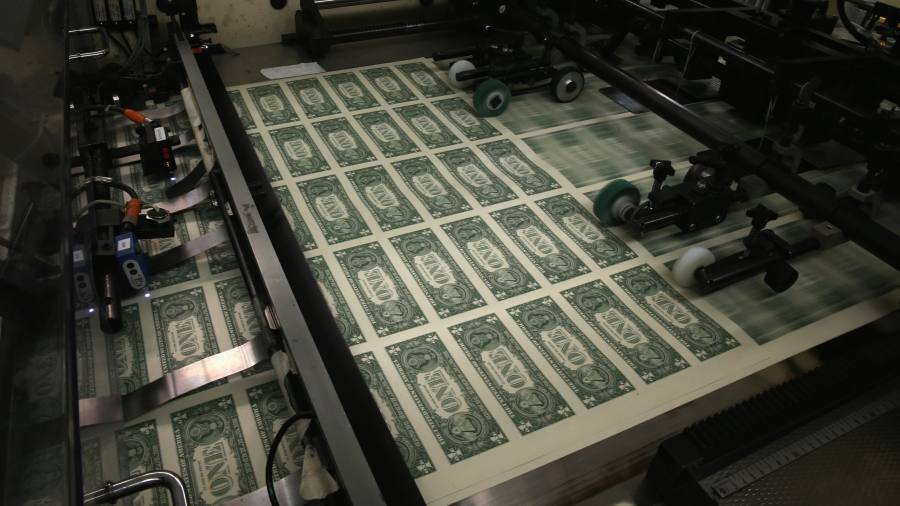The writer is an FT contributing editor
In the early 20th century, print advertisements for banks featured a dollar amount of the bank’s capital, often above and larger than the name of the bank itself.
With bank failures a fairly regular occurrence, particularly in the agricultural Midwest, depositors had to be wary. They would get something back from the receiver, but on average only about 60 per cent of what they’d held.
After the Great Depression, bank capital disappeared from bank advertising. It didn’t matter anymore. In 1933, Congress had authorised the Federal Deposit Insurance Corporation, a fund that guaranteed at the time up to $2,500 in deposits. Most people didn’t have to think about bank capital because they no longer had reason to worry that their dollars would suddenly be worth less.
For the past four years I have been researching and writing a history of the dollar, work that has confronted me with a metaphysical question: what is a dollar? The answer has changed consistently since the early American republic adopted the silver Spanish milled dollar as a currency standard. And the question has been brought into focus again by the failures of Silicon Valley Bank and Signature Bank.
We could say that a dollar is now a liability on the balance sheets of the banks of the Federal Reserve system. That would be true but inadequate. It describes only a fraction of the dollars we actually use. Most dollars are deposits, liabilities of commercial banks. They don’t even have to be American banks. Outside of the US, banks can and do regularly denominate deposits in dollars and call them dollars.
There is a limit, however, to who gets to say something is a dollar. I cannot go to a football ground, write out a promissory note in dollars for a beer and expect that my dollar note will continue to trade at par. That brings me to an uncomfortably circular definition. A dollar is any financial instrument that will at all times clear at par with other dollars. My beer note may be denominated in dollars but without some kind of guarantee, it is not likely to trade one for one with a Federal Reserve note.
The only institutions with the power to provide this guarantee are the Fed, the Federal Deposit Insurance Corporation, and the US Treasury. Since the 2007-8 financial crisis, these institutions have made clear — even if they don’t say it out aloud — that they prefer a hasty guarantee to the possibility of chaos. Each time they do, they add to the list of what we might de facto consider a dollar. But to have the US government back a dollar you create is a privilege, one that should come with explicit obligations. We can’t spell these out or enforce them until we can be honest with ourselves about who is allowed to create a dollar — and who should be.
Bankers like to have their deposits guaranteed but they do not like to pay for it. Deposit insurance was not a new idea in the 1930s. Already before the US Civil War five states offered some form of pre-funded guarantee on the physical notes that banks were then allowed to issue. By the 1920s, eight states offered a similar guarantee on deposits. The programmes were spotty, underfunded and before the Depression never turned into federal law.
In the late 1950s, European banks began letting customers hold dollar-denominated deposits — what we now call eurodollars. By the end of the 1960s, the Fed had begun offering swap lines with other central banks, trading dollars as needed for other currencies. As Robert McCauley and Catherine Schenk have argued, the swap lines quietly served to manage liquidity risk for eurodollars, creating a kind of deposit guarantee.
During the financial crisis and the early months of the pandemic, swap lines between the Fed and other central banks again guaranteed dollar-denominated deposits abroad. Eurodollars do not subject banks to US regulation. They do not require premiums to the FDIC. But they have a tacit guarantee. They are dollars.
After a run this week the FDIC guaranteed the deposits of Signature Bank and SVB — not just the $250,000 per-person limit for which the banks had paid premiums, but all deposits. With a single decision, the definition of a dollar again expanded. We usually talk about these ex-post guarantees in terms of moral hazard. How do you prevent bad behaviour without the threat of punishment?
We should think instead about the privilege of creating dollars and what it should cost — in extra regulation or insurance premium. And we should ask and attempt an honest answer to a blunt question: what is the limit? Who gets to make dollars?
Read the full article here



